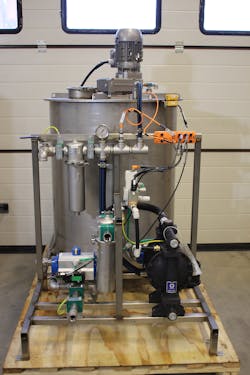COVID-19 has hit everyone globally, regardless of country, industry or company size. However, as countries, industries, and companies begin to recover, some companies—especially forging companies—face an almost unprecedented demand for parts. Press operators are pressured to run their machines as fast as possible because of a global shortage of parts and the fact is that suppliers are struggling to meet the demand.
While demand and production remain high, what must not be neglected are quality lubricant and die lubrication. The difference between proper systems and bucket approaches can be as different as night and day. Using poorly mixed lubricant creates many problems and issues. If poorly mixed lubricant is compounded with a poor application, you get the ingredients for disaster: for the press, for the operator, and for the quality of the forged parts. Design Management Konsulting Oy, DMK, offers solutions to both lubricant-mixing and application which allow the forging shop, press, and operator to enjoy the benefits of properly mixed lubricant that is properly applied—creating savings through improving process conditions and increasing output.
The Bucket Approach
The problems associated with poorly mixed lubricant are numerous. Many firms across the industry use the bucket approach where they add water to raw lubricant, mix by hand, and apply it as long as it looks ok. Although the bucket method is simple and efficient, it's an outdated practice that creates poor-quality lubricant with solids that are either too high or too low. Both of which can destroy dies, create poor parts, and most importantly, waste time and money needlessly.
If not enough water is added when mixing die lubricant, the amount of solids in the lubricant goes up increasing viscosity. High-viscosity lubricant is difficult to spray, regardless of whether a hand wand or an automatic spray system is used. High-lubricant viscosity requires better atomization of the lubricant. (Atomization is the transformation of a liquid into small, fine droplets.) If the lubricant is not properly atomized, the lubricant film in the die suffers since it does not coat the die properly. This results in excess lubricant in some areas of the die and leaves minimal to no lubricant in other places. This will cause forgings to stick to the die, or worse, over and underfill the die in different places of the same hit.
High viscosity and poor atomization are just the beginning of problems with high-solid lubricant. The drying time of the lubricant increases due to the high solids, resulting in lower press operating efficiency. In addition, the greater the amount of graphite in the lubricant, the more polluting it will be to the surrounding environment. Since the high-solid lubricant pollutes the environment faster, the lubricant build-up increases and creates additional problems. All of the above contribute to reduced die life, an increase in die-change delays, and the added cost entailed in using too much lubricant.
The immediate and obvious answer to high-solids lubricant is to over-dilute the lubricant in order to avoid all of these problems. This is not the best solution since over-diluted lubricant also has significant problems. The atomization of the lubricant will be better, but the coverage of lubricant in the die will be poor. With less graphite in the lubricant, the protective graphite film in the die becomes poorer. If the graphite film is poor, the cooling of the die will be lessened, producing an increase in friction. Poor cooling causes the dies to undergo higher thermal cycling which, in turn, wears out the dies more quickly. Additionally, with a poor lubricant film, the friction between the forging and the die increases, and the forging may stick to the die. Even if the forging does not stick to the die, there is the risk that the forging will underfill the die due to reduced friction. An underfilled die means poor quality parts with poor tolerances and an increase in the potential for reruns and recycling.
The ultimate result of poorly mixed graphite, with solids either too high or too low, is increased die wear, increased die-change delays, poor quality, poor yield, poor productivity, and an increase in costs. Therefore, it's imperative that the lubricant be mixed properly.
The Solution
DMK has developed a PLC-controlled Mixing & Dilution station for forging shops so that the operator can always have properly mixed die lubricant ready to use without worry. The DMK Mixing and Dilution station consists of 2 separate tanks and a control skid. The operator connects the raw lubricant tote to the system and sets the preferred dilution ratio on the PLC touch panel. The system then automatically transfers raw lubricant and adds water to the mixing tank, dilutes it, mixes it, and transfers the fully diluted lubricant to the holding tank. The system repeats this process and keeps the holding tank level full allowing the operator to withdraw properly diluted lubricant from the holding tank. When the tote becomes empty, an alarm alerts the operator to replace the tote. With this simple, yet fully automated, system, the operator is guaranteed to have properly mixed lubricant.
The advantages of having properly mixed lubricant are numerous. Appropriate solids mean proper viscosity, which means proper atomization. Proper atomization allows for proper coverage which results in shorter drying time and reduced pollution. Proper coverage also means that the lubricant will work as intended, provide the proper die-cooling effect, and reduce friction when forming. This also means that with each hit the billet can be properly formed by the die with no under or overfill. This, in turn, improves die life, reduces die-change delays, increases press efficiency, productivity, and profitability.
Pay Attention to Application
Proper mixing of die lubricant provides a simple and significant step forward in the effort to improve and modernize the production of the press and may fix many problems the press has in forming simple and more complicated parts. However, properly mixed lubricant is useless unless it can be applied properly. Many press operators use a hand wand which allows the operators to spray each die by hand and apply lubricant to the best of their abilities, but this is not without limitations. When spraying the dies by hand, each die will be unevenly coated, inconsistently coated, and the amount of lubricant sprayed will be different. All these attributes create problems, reduce productivity, and add cost. Pollution is also increased as the operator typically will spray past the die, polluting and creating graphite build-up in the surrounding area.
Differently coated dies create inconsistency in the parts that are hit. If some dies receive a large amount of lubricant during production, the operator risks overfilling the dies; conversely, if the dies receive a small amount of lubricant, the operator then risks underfilling the dies due to poor friction. Neither of these situations is desirable and may result in shortened die life, increased die-change delays, and bad quality parts. If the parts do not meet quality standards due to poor lubricating conditions, the parts may need to be rerun or recycled, thus increasing production costs and reducing production efficiency.
Other problems that arise from typical hand-spray applications are high pollution, high thermal cycling, and high lubrication costs. High pollution comes from over-spraying the die and spraying past the die. When this happens, the lubricant is released into the surrounding environment creating build-up and causing problems such as that on the punch. This is a very wasteful approach.
High thermal cycling is caused by poor lubrication of the dies, something that creates a poor cooling effect on the dies. The dies need a certain amount of lubricant to properly cool the surface and when there is not enough lubricant, the die does not cool and experiences higher than normal thermal cycling, and with each successive hit the dies wear out faster than they are designed to. Finally, the lubrication cost increases in multiples, caused by over-spraying of the lubricant past the dies, and over-spraying of the dies themselves.
The need to properly apply lubricant to each die, hit after hit, is obvious. And one answer on how to do this is the DMK approach, a PLC-controlled lubrication application system. The lubrication system guarantees repetitive and consistent die lubrication, hit after hit, part after part. The typical PLC-controlled system consists of positive displacement-metering pump(s) with a “pulse-free” linear flow that pumps filtered lubricant from a holding tank to customer-specific spray headers. Each header is shaped and orientated for each specific die in order to allow for totally even coverage of the die. In some cases, the headers are located around the die, where there is sufficient space allowance. Other headers are located on robotic arms which move in and out between hits, spray different dies using customer-specific recipes, and are optimized for process efficiency and profitability.
The use of automation also allows for an increase in press-cycle time. In cases where applying lubricant manually takes 10 to 20 seconds, an automated system can do the same job in 1 to 5 seconds. This major improvement may double or triple the output of the press if the restriction is only due to die lubrication, which in most known cases it is. With higher output, production efficiency goes up and the cost per hit and per part goes down.
The benefits of using the DMK PLC-controlled system are enormous. Some studies report pollution reduction by up to 90% and a 90% reduction in lubrication costs because there is neither overspray nor lubricant being sprayed into the surrounding environment. Consistent spray also means improved die life and consistent friction. This, in turn, improves the quality of parts being manufactured, creating value through improved efficiency, reduced costs, and improved forgings.
In today’s highly competitive and demanding market, manufacturers need to look at areas they often neglect if they want to improve their process. Simple improvements such as proper mixing of lubricant can save a company both time and money. Upgrading the lubrication method can create even more value through improved tool life, better press efficiency, and cost savings. It is up to forging shops as to how and when they want to save and improve their process. DMK is willing to help provide the support and services required to do so.
About the Author
Daniel Vila-Flor
CEO, Design Management Konsulting Oy (DMK Oy)
Chief Executive Officer at Design Management Konsulting Oy

